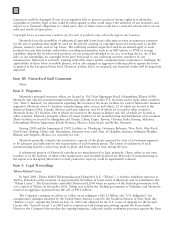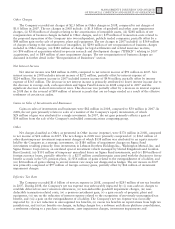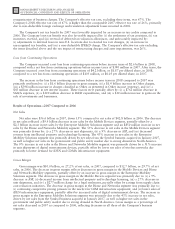Motorola 2008 Annual Report Download - page 48
Download and view the complete annual report
Please find page 48 of the 2008 Motorola annual report below. You can navigate through the pages in the report by either clicking on the pages listed below, or by using the keyword search tool below to find specific information within the annual report.
What were our major challenges and accomplishments in 2008?
•In our Mobile Devices Business: 2008 was a very difficult year for our Mobile Devices business. Demand
for Motorola’s wireless handsets declined in 2008 primarily due to limited product offerings in critical
market segments, particularly 3G products, including smartphones, as well as very low-tier products. We
also were impacted by the worldwide economic downturn in the second half of 2008, as the overall market
for handsets grew at a slower rate than in 2007, particularly in the fourth quarter. Motorola believes it lost
approximately 6 percentage points of market share and estimates its global market share was approximately
8% for the full year 2008.
During 2008, the Mobile Devices business launched a number of new products, including: new feature
phones for GSM, CDMA and UMTS technologies; additions to the ROKR family of music devices;
additions to the smartphone portfolio, including Q and MING devices, for consumers who multi-task and
want flexibility in today’s business environment; and several handsets at affordable price points for
consumers with everyday communications needs.
The Mobile Devices business has taken significant actions in 2008 to reduce its size and cost structure,
including actions to simplify its wireless handset platforms and enhance its product portfolio. To that end,
we announced that our silicon strategy is to use two primary silicon providers to achieve faster time to
market and reduce costs. Our software platforms will focus on fewer operating systems, including Android
(a Google-developed, royalty-free platform) and Windows Mobile (a Microsoft platform). Our portfolio
focus will be increasingly on 3G and smartphone devices, particularly in the mid- and high-price tiers, while
continuing to focus on our proprietary iDEN technology and CDMA software platforms. In addition to our
portfolio streamlining and enhancement efforts, over the next year we will also increase our focus in
priority markets. These markets will include North America, Latin America and parts of Asia, including
China.
Actions taken throughout the year, including the decisions to reduce platforms and focus on key markets,
resulted in a lower operating expense cost structure in 2008 compared to 2007.
•In our Home and Networks Mobility Business: The Home and Networks Mobility business improved its
operating margin and remained the world’s leading provider of digital entertainment devices. Total net sales
in the home business grew by 16% in the year, which included significant business growth outside of the
U.S. The business enhanced its portfolio of advanced video, voice, and data platforms with several new
product introductions, including DOCSIS 3.0 products, MPEG-4 compression technology, and the DCX-
series of multimedia digital entertainment devices. The home business completed the acquisition of Dahua
Digital to increase our position in the rapidly growing cable market in China.
Net sales in the networks business were lower primarily due to the absence of net sales by ECC that was
divested at the end of 2007. The networks business also experienced a decline in sales of iDEN, CDMA and
GSM technologies, while sales of WiMAX and UMTS technologies and related services increased. Motorola
continued its investments in and focus on next-generation wireless broadband technologies, including
WiMAX and LTE. Our first sales for WiMAX network equipment were recorded in the fourth quarter of
2008. In addition, Motorola was the first wireless networks infrastructure supplier to demonstrate a
handoff between CDMA EV-DO rev. A and LTE, as well as the first over-the-air session of LTE in the
700MHz band. Despite the challenges facing the wireless infrastructure industry, Motorola’s networks
business improved its profitability compared to 2007 and demonstrated leadership in next-generation
technologies.
•In our Enterprise Mobility Solutions Business: In 2008, the Enterprise Mobility Solutions business
delivered solid results, including an improvement in operating margin. The business continued to maintain
leading market share positions in several highly competitive markets.
Within the government and public safety market, sales grew as demand for integrated, interoperable public
safety communications increased. As new and better spectrum utilization evolves, demand and sales have
increased for high-speed data applications, such as video surveillance, dual-mode devices, including the
MOTOTRBO product family, and other data-based products. In addition to our continued success in the
U.S., our largest market, the business experienced significant growth in all markets outside of the U.S. The
business acquired a controlling interest in Vertex Standard Co., Ltd. to further expand its two-way radio
portfolio and open up new market opportunities, both in the U.S. and internationally. We also announced
40 MANAGEMENT’S DISCUSSION AND ANALYSIS
OF FINANCIAL CONDITION AND RESULTS OF OPERATIONS
























